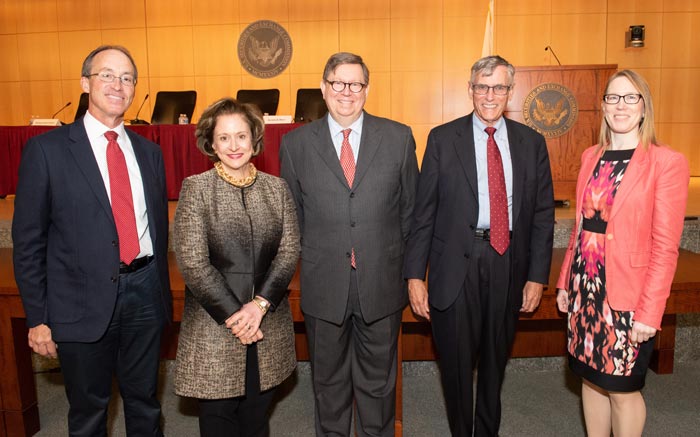

As the SEC began implementing Reg NMS, the market centers continued remaking themselves. Most were adjusting to the new regulatory regime, but the one that still counted most was also reacting to external factors. Although still strongly supported by NYSE CEO Richard Grasso, the specialist system had been increasingly vulnerable ever since it had performed poorly in the face of the 1987 market break. The specialist firms were also seeing their influence erode as Chicago-based derivatives traders began to determine market prices. As market changes curtailed their influence, internal factors also weakened them, particularly public scrutiny of specialist firm finances as they began to go public. Then there was the tempest touched off when Grasso’s extravagant compensation hit the headlines. In September 2003 Grasso departed, no longer able to hold back the electronic tide that threatened to sweep away the specialist system.
But the NYSE would have had to change regardless. Catherine Kinney served as NYSE President during the mid-2000s. She insisted that even before Reg NMS, and even before the controversies, exchange officials were aware that the specialist system was never going to be able to support the volume that the NYSE had to handle in order to compete with the new automated markets. “We started down that path because we were going to have to go there,” she recalled. 53
New CEO John Thain acted accordingly. As the SEC put the final touches on Reg NMS, Thain engineered a merger between the NYSE and Archipelago ECN. As part of the transaction, finalized in 2006, the NYSE was demutualized. The next April, the public company, NYSE Group, merged with the Euronext, a merger of five exchanges on the European Continent. By mid-2008, although NYSE-Euronext was in a position to better compete in the new marketplace, it handled only 25 percent of the trades in NYSE-listed stocks—about the same as the NASDAQ, which had buttressed its own position in 2005 by acquiring Instinet. That year, NYSE specialists became designated market makers obligated to quote the NBBO.
Once membership organizations, both NASDAQ and NYSE were now public. They had access to investment capital but were also under great pressure to make money. As any good business does, they looked for a competitive advantage. Like the ECNs before them, NASDAQ and NYSE responded to competitive pressures by providing faster executions.

The informational advantage possessed by traders had always been a matter of contention. Members of the exchange always got better market access than outsiders. When, in 1878, telephone lines reaching upstairs offices were installed on the periphery of the trading floor, the most prosperous members promptly leased lines connecting their upstairs offices with colleagues nationwide. One hundred years later, the general public was still reading the financial pages and placing orders based on information hours or even days old, while well-wired professionals always got the better of the deal.
After commission rates were unfixed in 1975, broker-dealers had begun seeking to replace lost revenues by opening arbitrage desks, earning money by exploiting “stale” prices. By the 1980s, they had begun to use computer algorithms to detect price anomalies, a necessity as execution times sped up. By 1984, the frequency of the average trade on even a slow market like the NYSE was down to two minutes—by 2005 it was down to 14 seconds. But the electronic markets that it competed with were executing trades at one second or less. Reg NMS, by requiring that market markets execute trades at the “best price,” and markets that could not respond to an order within one second could be ignored, arguably encouraged greater automation and a greater focus on speed. Traders began employing faster computers and writing better algorithms to do one thing—identify price differentials. The Securities Information Processor that calculated the NBBO being relatively slow, market participants coming to be called “high frequency traders” quickly figured out how to find price information through faster means and to act on it to their advantage. By 2008, execution times were no longer being measured in seconds—high frequency traders were executing transactions in three to seven milliseconds.
By 2009, about 50 percent of all trades in U.S. securities markets qualified as high frequency trading and, not surprisingly, the financial markets were soon being reshaped to accommodate it. NYSE Euronext began building a “colocation facility” in Mahwah, New Jersey. When it opened in 2010, the exchange could charge broker dealers top dollar for the privilege of locating their computers just feet away from its “matching engines,” thus cutting out a few more milliseconds in execution time. Reg NMS and faster executions, meanwhile, were also transforming institutional transactions.
Since the days of manual markets, institutional trading had often been done differently. Institutions sought to avoid moving markets with their large orders, often by negotiating for price “upstairs” and then bringing their orders to the floor for execution. In the new world of electronic markets, institutions sought new ways to mask their large sized orders. Some institutional traders would break up orders into smaller orders, with reserve sizes below the top of book. Others chose to keep their transactions secret by trading in automated trading systems dubbed “dark pools.” Dark pools were not quite as sinister as they sounded—since every ATS had to be a member, FINRA (the successor to the NASD) could closely monitor the transactions. As with high frequency trading, a sense of perspective is important. As former Division of Market Regulation Director Erik Sirri pointed out, there have always been many ways to hide order flow and “one of the things that folks sometimes forget is that the exchanges themselves were not perfectly lit places.” 545
(53) October 5, 2009, Interview with Catherine Kinney, 32.
(54) April 29, 2015 Interview with Erik Sirri, 37.